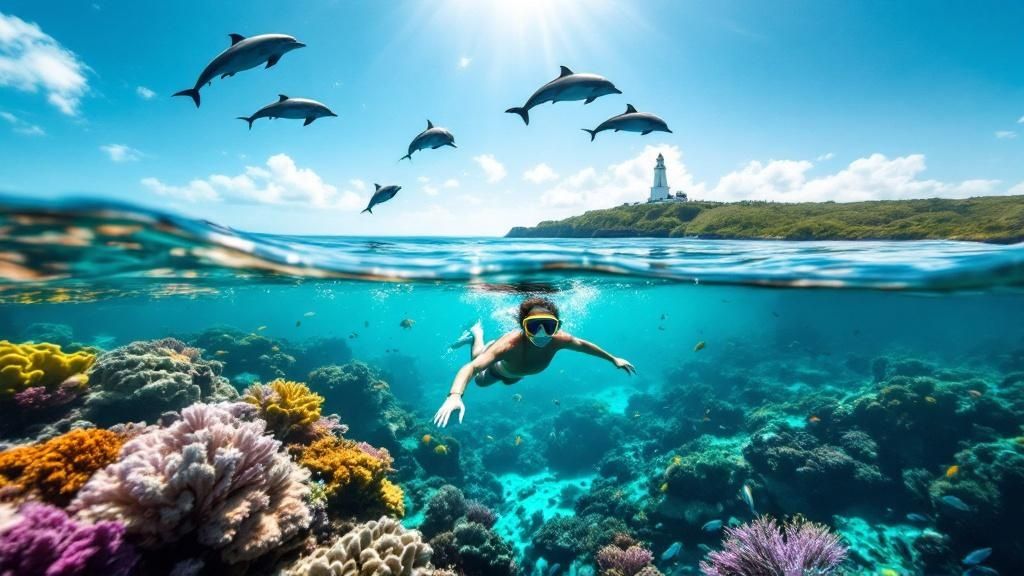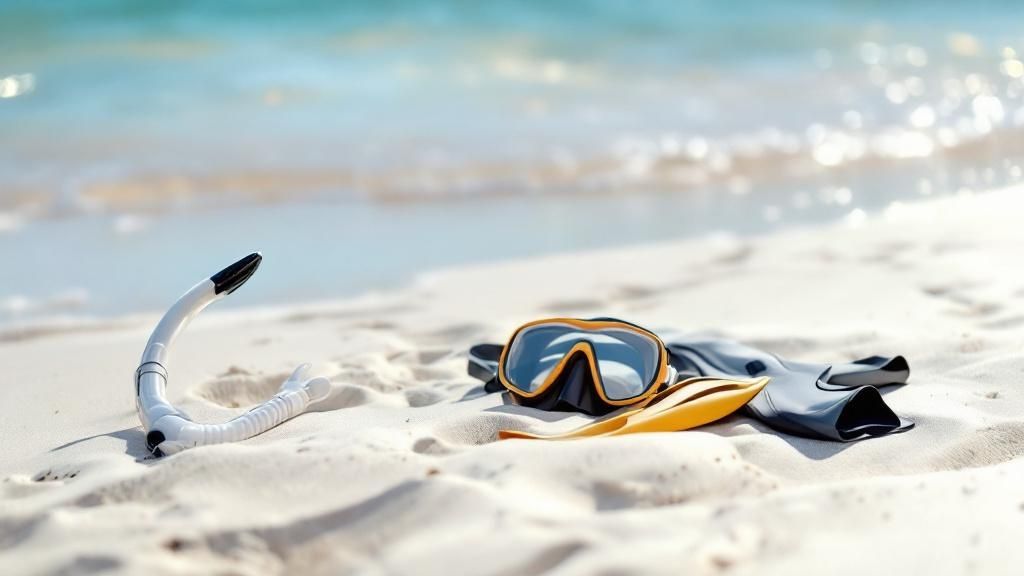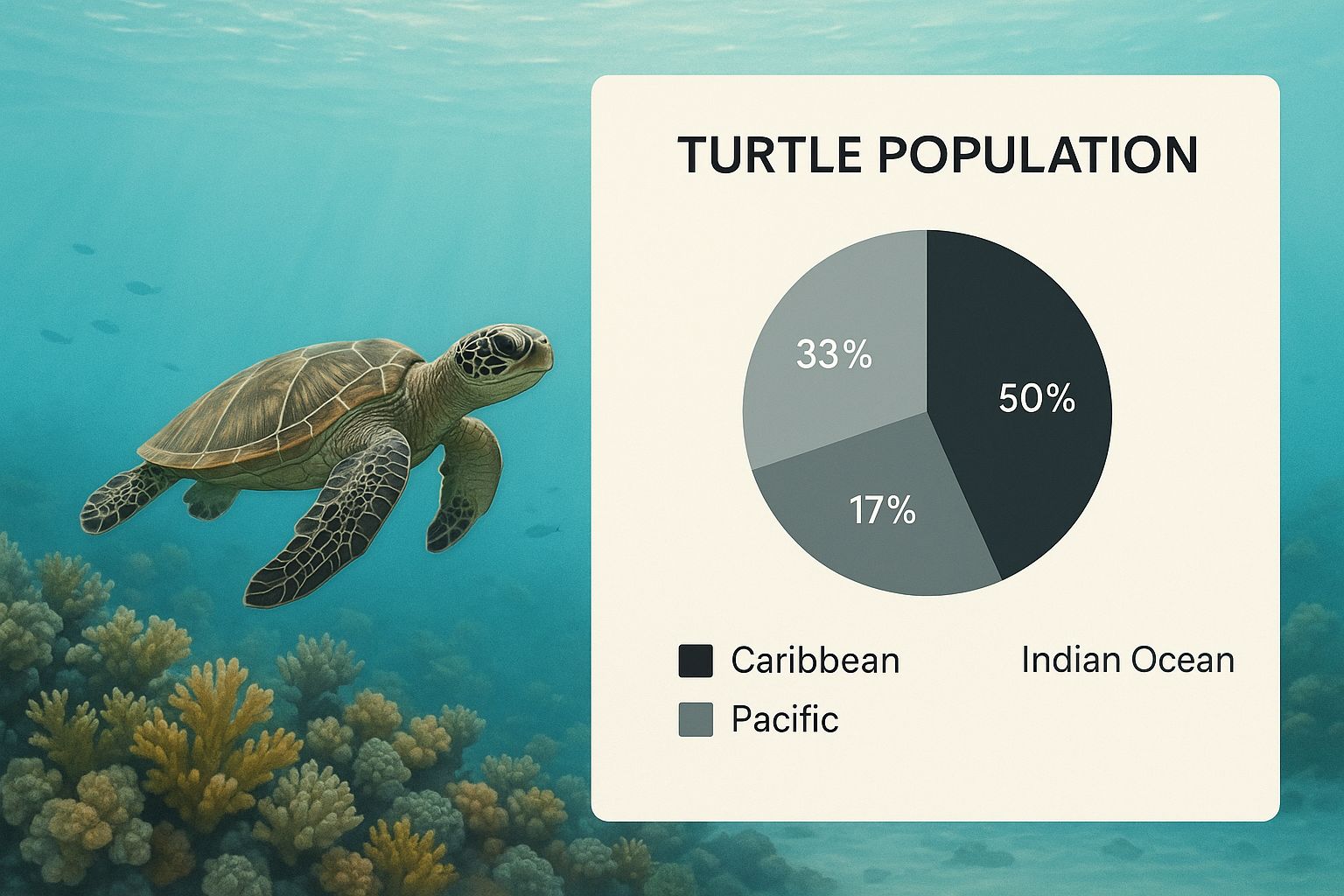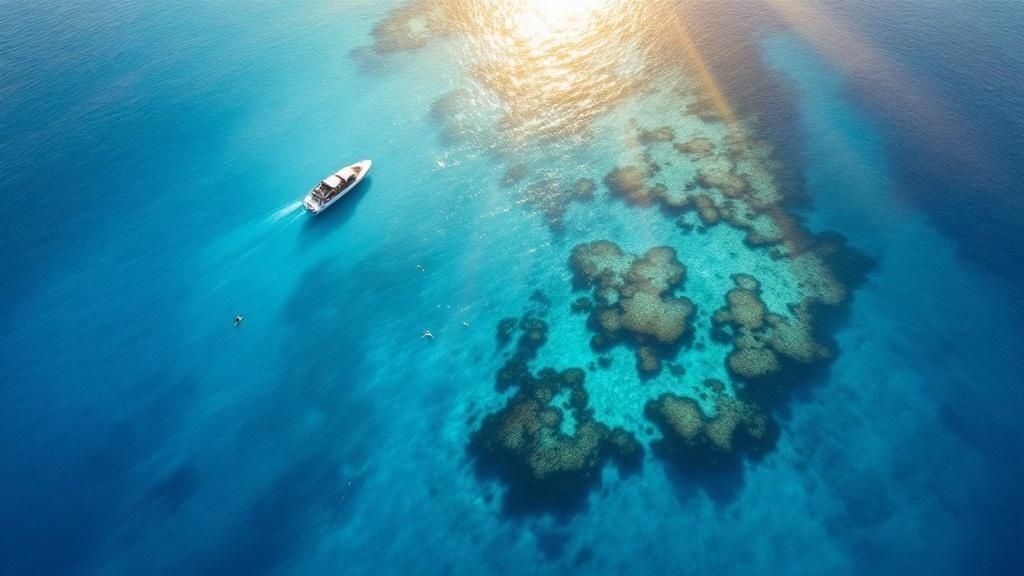Your Guide to the Captain Cook Snorkel Tour

If you're planning a trip to the Big Island, you’ve probably heard whispers about the Captain Cook snorkel tour. It’s not just another boat trip—it's an iconic adventure that beautifully merges world-class snorkeling with a fascinating slice of Hawaiian history. These tours whisk you away to the protected, crystal-clear waters of Kealakekua Bay, home to stunning coral reefs and the historic Captain Cook Monument. Honestly, it’s more than just a tour; it’s a quintessential Big Island experience.
Why This Tour Is an Essential Hawaiian Adventure
Picture this: you're floating weightlessly in calm, turquoise water, so clear you can make out the vibrant details of coral gardens 100 feet below. That's the magic of a Captain Cook snorkel tour. It delivers an incredible mix of natural wonder and compelling history that really sets it apart from anything else you can do here. The destination, Kealakekua Bay, isn't just a pretty spot—it's a living, breathing sanctuary.
The bay is a designated Marine Life Conservation District. Think of it as an underwater national park. This special protection has allowed its ecosystem to thrive with very little human impact, making the coral more vibrant and the fish more plentiful than almost anywhere else in Hawaii. This protected status is exactly why the bay has become a cornerstone of the Big Island’s eco-tourism, drawing people who want to experience nature at its most pure.
A Journey Through Nature and History
What truly elevates this tour is its two-for-one appeal. You're not just swimming with colorful fish; you're swimming through a site of huge historical significance. This is the exact spot where British explorer Captain James Cook first landed in 1779 and, later, where he met his end. The stark white monument standing on the shoreline is a powerful reminder of this pivotal moment in Hawaiian history.
This blend of attractions makes the tour a hit with everyone, from die-hard marine life lovers to history buffs. One minute you could be mesmerized by a school of bright yellow tangs, and the next, you’re reflecting on the profound cultural events that unfolded right where you're floating.
Before we dive deeper, here’s a quick snapshot of what makes this tour so special.
Captain Cook Snorkel Tour at a Glance
This table breaks down the key highlights you can look forward to on your adventure.
| Feature | What to Expect |
|---|---|
| Location | Kealakekua Bay, a protected Marine Life Conservation District. |
| Marine Life | Abundant tropical fish, vibrant coral reefs, and frequent sightings of spinner dolphins. |
| Historical Site | Snorkel right next to the iconic Captain Cook Monument, marking a key point in Hawaiian-Western contact history. |
| Water Clarity | Exceptional visibility, often exceeding 100 feet, offering a clear view of the entire underwater landscape. |
| Accessibility | The best snorkeling spots are only accessible by boat, making a guided tour the ideal way to experience the bay. |
It's a unique combination that delivers an unforgettable day.
Kealakekua Bay is a place where every ripple in the water tells a story. You arrive for the world-class snorkeling but leave with a much deeper appreciation for Hawaii's rich cultural and natural heritage. It’s an experience that truly connects you to the island.
The bay’s importance as a protected area can't be overstated. It draws over 190,000 visitors annually, all hoping to see the thriving coral, schools of tropical fish, and playful spinner dolphins that call this sanctuary home. When you book a Captain Cook snorkel tour, you're not just signing up for a fun day on the water; you're becoming part of a legacy of responsible tourism dedicated to preserving this incredible place. It’s an opportunity to connect with the very heart of Hawaii.
A Journey Into Hawaiian History at Kealakekua Bay

Sure, the incredible marine life is the star of the show, but a Captain Cook snorkel tour is so much more than that. It’s a literal dive into history. The bay itself, whose name "Kealakekua" translates to "the pathway of the god," was a deeply sacred place for Native Hawaiians long before any Western ships appeared on the horizon.
When you float in these calm, clear waters, you're not just looking at fish and coral. You're hovering over the exact spot where two vastly different worlds collided, an event that would change the course of Hawaiian history forever. It's this powerful combination of natural beauty and profound history that makes the experience unforgettable.
The Arrival of Captain Cook
Picture this: It's January 1779. The renowned British explorer Captain James Cook sails his ships, the HMS Resolution and HMS Discovery, into this protected bay. His arrival was a spectacle, but it also happened to coincide with Makahiki, a peaceful, four-month festival celebrating the Hawaiian god Lono.
By a stroke of cosmic irony, the very shape of Cook’s ship—its sails and masts—looked remarkably like the sacred symbols of Lono. The Hawaiians, believing Cook was the god himself returning as prophesied, welcomed him with incredible ceremony and honor. For weeks, Cook and his crew were treated like deities.
Of course, this warm welcome was built on a massive cultural misunderstanding. The Hawaiians saw a god; Cook and his crew saw a friendly and convenient place to restock their ships.
A Welcome Wears Thin
The goodwill started to evaporate as the British ships lingered, putting a real strain on the island’s resources. When Cook finally left in early February, it seemed the encounter would end on a high note. But fate had other plans. A sudden storm damaged the mast of the Resolution, forcing an unwelcome return to Kealakekua Bay for repairs.
This time, things were different. The Makahiki festival was over, and with it, the perception of Cook as a god. Now, he was just a man, and his return felt suspicious and poorly timed. Tensions flared, coming to a head when a small cutter boat was stolen from one of Cook's ships.
On February 14, 1779, Cook went ashore to try and get his boat back by taking a high-ranking chief hostage—a common tactic for him, but a grave insult here. The attempt went horribly wrong. A large, armed crowd of Hawaiians confronted him on the shoreline, and in the chaos that followed, Captain Cook was killed.
The Monument You See Today
That stark white obelisk standing against the dark lava rock is the Captain Cook Monument. It’s a 27-foot-tall memorial erected in 1874, marking the approximate spot where he fell. Here's a fun fact: the small piece of land it sits on was actually deeded to the United Kingdom. So when you’re looking at it from the water, you’re technically looking at a slice of British soil.
For a deeper dive into the landmark itself, check out our complete guide to Captain Cook Monument snorkeling.
There's a powerful feeling that comes from floating in the same waters where Cook's ships once anchored. It connects you to the past in a way no history book ever could, turning a simple snorkel trip into something much more meaningful.
This rich backstory isn't just a side note; for many, it's a huge part of the appeal. Surveys actually show that about 70% of visitors are drawn here specifically because of the historical significance of Captain Cook's story. It elevates the whole experience from a fun day on the water to a genuine Hawaiian journey.
How to Choose the Right Snorkel Tour
Picking the perfect Captain Cook snorkel tour can feel a bit like choosing a surfboard—what’s right for a seasoned pro might not be the best fit for a first-timer. Kealakekua Bay has a bunch of excellent tour operators, so the real secret is matching the trip to your own idea of a perfect day on the water.
Are you picturing a laid-back, family-friendly cruise with all the amenities? Or is your style more of a fast-paced, thrilling ride that gets you in the water as much as possible? Thinking about your priorities is the first step to narrowing down the options and finding a tour that feels like it was made just for you.
Big Boat Comfort vs. Small Raft Adventure
The kind of boat you’re on will probably be the single biggest factor shaping your day. Your two main choices offer completely different vibes, and it really comes down to a classic trade-off: comfort or agility.
-
Large Catamarans: Think of these as the luxury liners of Kealakekua Bay. They’re super stable, incredibly spacious, and loaded with creature comforts. You’ll often find shaded decks, actual restrooms, fun water slides, and sometimes even cool underwater viewing windows. These boats are an amazing choice for families with kids, non-swimmers, or anyone who just wants to kick back and enjoy a leisurely day. They almost always serve a full lunch, turning the trip into an all-inclusive experience.
-
Zodiac-Style Rafts: These are the sports cars of the sea. They’re quick, nimble, and give you a much more intimate, up-close view of the stunning Kona coastline. Their speed and small size mean they can often zip into sea caves and explore lava tubes that the bigger boats can't get near. These tours are perfect for adventure-seekers and confident swimmers who prefer a smaller group and a bit of a thrill ride.
No matter how you get there, this is what you're coming to see. The vibrant, teeming reef is the main event.

This shot of a green sea turtle gliding over the coral perfectly captures the magic of the underwater world waiting for you in Kealakekua Bay. It’s what makes this place so incredibly special.
Comparing Key Tour Details
Once you’ve got a boat type in mind, a few other details come into play. Luckily, the tour operators here are all competing to give you the best day, which means you have tons of options.
Some outfits specialize in smaller, more personal trips. You might see a 4-hour tour for just 6-12 people, running somewhere between $120 and $180. On the other hand, the bigger catamarans might host 20-40 guests on a 5-hour trip, with prices from $150 to $220, usually reflecting the included lunch and extra amenities. To get a feel for what's out there, it's worth checking out the specific offerings from local Big Island operators.
To help you sort through it all, here's a quick comparison of what to expect.
Comparing Captain Cook Snorkel Tour Operators
This table gives you a side-by-side look at the different tour styles to help you find the best match for your crew and your vibe.
| Tour Type | Typical Group Size | Best For | Price Range (Approx.) |
|---|---|---|---|
| Large Catamaran | 20-40+ guests | Families, non-swimmers, comfort-seekers | $150 – $220 |
| Zodiac-Style Raft | 6-16 guests | Adventurous snorkelers, small groups | $120 – $180 |
Ultimately, both paths lead to the same incredible destination. The choice is all about how you want to get there.
Choosing your tour is like planning a hike. Do you want the wide, paved path with beautiful lookout points and picnic tables, or the rugged, narrow trail that leads to a hidden waterfall? Both are amazing, but they offer very different experiences.
Making the Final Decision
So, how do you lock it in? Just ask yourself a few quick questions:
- Who are you traveling with? If you’ve got young kids or older family members along for the ride, the stability and onboard amenities of a big catamaran are probably your best bet.
- How comfortable are you in the water? All the tours are great for beginners, but getting in and out of a zippy raft from a ladder requires a little more agility.
- What’s your main goal for the day? If you want to maximize your snorkel time and get a unique, close-up tour of the coastline, the raft is a fantastic choice. If you're dreaming of a full day of sun, fun, food, and relaxation on the water, a catamaran is tough to beat.
By weighing these things—the boat, the duration, the group size, and the perks—you can confidently book the Captain Cook snorkel tour that’s going to give you that perfect, unforgettable day in one of Hawaii’s most precious spots.
What Marine Life You Can Expect to See
While the history of Kealakekua Bay is incredible, the real magic of a Captain Cook snorkel tour starts the second you dip below the surface. The bay is a protected Marine Life Conservation District, and that special status has turned it into a true underwater paradise. Imagine a busy, thriving city where the locals are thousands of vibrant fish and other sea creatures.
The moment your mask hits the water, you're thrown into a world of brilliant color and constant motion. The water here is famously clear, with visibility often hitting 100 feet or more. Sunlight just dances across the sprawling coral gardens below, making you feel like you've been dropped right into a nature documentary.
The Dazzling Reef Inhabitants
One of the first things you'll notice are the massive, shimmering schools of fish that move together like a single, fluid being. You’ll find yourself completely surrounded by clouds of brilliant yellow tang, their bright color popping against the deep blue water. These guys are the lifeblood of the reef, constantly grazing and keeping the coral healthy.
Look a little closer at the coral itself, and you'll spot countless other species. Delicate butterflyfish, usually in pairs, flit gracefully among the coral branches. You might see the Milletseed butterflyfish, a local favorite, or the stunningly patterned Ornate butterflyfish. Also, keep an eye out for Hawaii's state fish, the humuhumunukunukuāpuaʻa (reef triggerfish), with its quirky shape and bold personality.
Snorkeling in Kealakekua Bay is like stepping into another dimension. The sheer volume of fish is astounding. Being enveloped by a school of thousands is a humbling, unforgettable moment that connects you right to the pulse of the ocean.
Tucked away in rocky crevices and under ledges, you’ll find the more reclusive characters. If you’re patient, you might be rewarded with a glimpse of a moray eel poking its head out, its patterned skin providing the perfect camouflage. While almost everything you'll see is harmless, it's always smart to have a healthy respect for all wildlife. For a broader look at marine life, some people find articles like 8 Of The Worlds Most Dangerous Fish And Sea Animals interesting for context.
The Stars of the Show: Spinner Dolphins and Honu
The fish are a guarantee, but Kealakekua Bay is world-famous for its most charismatic residents: spinner dolphins. A huge pod calls this bay their resting area, so the odds of seeing them on your tour are very, very high. You’ll often spot them from the boat, leaping and spinning through the air in these incredible acrobatic shows. It's a truly moving experience to see these playful, intelligent animals in their natural home.
Another beloved local you'll likely meet is the honu, the Hawaiian green sea turtle. These gentle, ancient mariners are a common sight, gliding effortlessly through the water. It’s not unusual to see them resting on the sandy bottom or nibbling on algae near the reef. Watching a honu is a peaceful, almost spiritual encounter that really captures the calm spirit of the islands.
Potential Bonus Sightings
The wonders don't stop there. Depending on the day and the season, you could be in for some even bigger surprises.
- Manta Rays: While not a daily thing, majestic manta rays sometimes cruise through the bay to visit "cleaning stations," where small fish remove parasites from their skin.
- Spotted Eagle Rays: These elegant rays are occasionally seen "flying" through the water in the deeper parts of the bay. Their spotted patterns make them impossible to miss.
- Humpback Whales: If your Captain Cook snorkel tour is during the winter months (usually December through March), you have the incredible bonus of potential humpback whale sightings. Hearing their haunting songs underwater or seeing a massive breach from the boat is an experience that will stick with you for life.
Every single trip offers a unique window into this thriving underwater world. The sheer density and variety of life here make it crystal clear why protecting this bay is so critical for the future.
How to Prepare for Your Snorkel Adventure

A little bit of prep work can be the difference between a good day and an absolutely incredible day out on the water. Getting ready for your Captain Cook snorkel tour ahead of time means you can just relax and soak it all in, without any of those nagging "I forgot the…" moments.
Think of it like packing for a day hike on the island. You wouldn't hit the trail without water and good shoes, right? It's the same for an ocean adventure. The key is to pack smart, not heavy, bringing just what you need to stay comfortable, protected, and ready to capture the magic.
What You Should Absolutely Pack
Your tour operator has the main snorkel gear covered, but a few personal items are what really dial in the perfect day. I always recommend putting together a small "go-bag" with these essentials so you're ready for anything.
Here's my go-to checklist of must-haves:
- Reef-Safe Sunscreen: This is a big one, and it's non-negotiable. So many common sunscreens have chemicals like oxybenzone that are seriously damaging to our precious coral reefs. Always, always grab a mineral-based sunscreen with zinc oxide or titanium dioxide. It protects your skin and the stunning underwater world you're about to visit.
- Swimsuit and Towel: This might seem obvious, but wear your swimsuit under your clothes. It makes getting ready at the bay so much easier. A quick-drying towel is also a game-changer for when you hop back on the boat.
- A Change of Clothes: Trust me on this one. After a few hours in the saltwater, pulling on a dry set of clothes for the ride back to the harbor is a small luxury that feels absolutely amazing.
- Waterproof Camera or Phone Case: You are going to see things you'll want to remember forever. Whether you have a GoPro or just a waterproof pouch for your phone, make sure you have something to capture the underwater scenery. You won't regret it.
- Reusable Water Bottle: Most tours provide drinks, but I always bring my own water bottle. It's the best way to make sure you stay hydrated and helps cut down on plastic waste.
With these items in your bag, you're set for a comfortable and unforgettable trip. The right preparation not only makes your day better, but it also shows respect for the beautiful environment we're lucky to share. For more pro tips on getting the most out of your time in the water, check out our complete guide to Big Island snorkeling.
What Your Tour Will Likely Provide
One of the most common mistakes I see is people overpacking. Remember, your tour operator has done this literally thousands of times. They know exactly what's needed for a safe and fun time in the water, so you can probably leave these things at home.
Pretty much every reputable tour will include:
- High-Quality Snorkel Gear: This means a mask, snorkel, and fins. The crew are experts at making sure everything is sanitized and will help you find a mask that fits your face perfectly—no leaks!
- Flotation Devices: From life vests to pool noodles, there will be plenty of options to help you float effortlessly. This is fantastic for beginners or anyone who just wants to conserve energy and relax in the water.
- Refreshments and Snacks: Nearly every Captain Cook snorkel tour offers water, juice, and some light snacks. If you're on a longer tour, especially on one of the bigger catamarans, they often include a full lunch.
The real secret to a perfect snorkel trip is just to relax. The more comfortable and calm you are, the more you'll see. Trust your gear, listen to your guides, and just let yourself float. The underwater world will open up to you.
Knowing what's already provided lets you pack light and focus just on your personal comfort items. It makes the whole day smoother from start to finish.
Snorkeling Responsibly with a Spirit of Aloha
Getting to experience a Captain Cook snorkel tour in Kealakekua Bay is a true privilege. This isn't just another beautiful spot; it's a fragile natural treasure and a place held sacred in Hawaiian culture. To really appreciate it, we need to come as respectful guests and embrace the spirit of mālama i ka ʻāina—a deep-seated commitment to care for and protect the land and sea.
This idea goes way beyond just "leave no trace." It’s about being a guest in a very special, living home. You wouldn't walk into a friend's house and start messing with their stuff, right? The same courtesy applies here, in this incredible underwater world.
The Look But Don’t Touch Rule
The single most important rule in the ocean is beautifully simple: look, but never, ever touch. It’s strictly forbidden to chase, harass, or make any kind of contact with the marine life here. That goes double for the bay's most treasured residents—the protected spinner dolphins and the peaceful honu (Hawaiian green sea turtles).
Giving these animals a wide berth is non-negotiable. The dolphins come to the bay to rest, and bothering them can mess with their essential survival patterns. Getting too close to a honu just stresses them out. When we watch them from a respectful distance, they stay safe and comfortable in their home.
The coral reef isn't just a collection of pretty, colorful rocks. It's a sprawling, delicate city built by millions of tiny, living animals. A single touch can wipe out decades of growth and damage the entire ecosystem that calls it home.
That hands-off approach applies just as much to the reef itself. It's so important to remember that coral is alive. Standing on it, bumping it with your fins, or even just touching it with your hand can kill it instantly. One clumsy moment can destroy years of slow, patient growth and harm all the creatures that depend on that reef for food and shelter.
Your Choices Make a Real Difference
Being a responsible snorkeler actually starts before you even dip a toe in the water. What you put on your body can directly affect the health of this fragile place.
- Choose Reef-Safe Sunscreen: This is a big one. Common sunscreens are loaded with chemicals like oxybenzone and octinoxate that are proven to cause coral bleaching. Always go for mineral-based sunscreens that use zinc oxide or titanium dioxide instead. It’s one of the easiest and most powerful things you can do for the reef.
- Secure Your Stuff: Make sure everything you bring—water bottles, hats, cameras—is secure on the boat. Anything that blows overboard becomes marine debris that can entangle and harm wildlife.
- Listen to Your Guides: Your tour crew knows this bay inside and out. They'll give you instructions based on years of experience to keep you safe and to protect the environment. Follow their lead!
When you embrace these simple actions, your Captain Cook snorkel tour becomes more than just a fun day out. It becomes an act of preservation, helping to ensure that the magic of Kealakekua Bay is still here for generations to discover.
Common Questions About the Captain Cook Snorkel Tour
Even after getting all the details, you might have a few lingering questions. That’s perfectly normal. Planning a trip to Kealakekua Bay should be all about the excitement, not the stress, so let's tackle some of the most common things people ask before they book.
Think of this as the last few pieces of the puzzle falling into place. These are the practical questions that pop up right when you're about to commit, and having the answers ready makes everything feel right.
Is This Tour Good for Beginners or Non-Swimmers?
Absolutely. In fact, this is one of the best spots on the island to get your fins wet for the first time. The crews on these tours are total pros at making everyone, regardless of skill level, feel confident and safe in the water. They'll give you a full rundown on using the gear, and there are always high-quality flotation devices like life vests or pool noodles on hand.
The bay itself is naturally protected, so the water is usually incredibly calm—almost like a giant swimming pool. It’s a perfect, low-stress environment to learn. Even if you're not a swimmer, you can easily float on the surface with a vest and just put your face in the water to see the amazing world below. The key is to just let the crew know your comfort level; they'll take it from there and make sure you have an incredible, secure experience.
When Is the Best Time of Year for This Tour?
Honestly, there's no bad time. Kealakekua Bay offers fantastic snorkeling all year round. The summer months, roughly from May through September, typically have the calmest, glassiest water and warmest weather. It's just sublime for a lazy day of snorkeling.
But visiting in the winter—from December through March—has a massive bonus: it’s humpback whale season. While you won’t be snorkeling with the whales, the boat ride over and back becomes a whale-watching tour in its own right. It's an unforgettable sight. For the best water clarity on any given day, morning tours are almost always the way to go, as the winds tend to pick up in the afternoon.
The most important decision isn't what time of year to go, but simply deciding to go. Each season offers its own unique magic, from the glassy waters of summer to the whale songs of winter.
Can I Snorkel at the Monument Without a Tour?
Technically, yes, but it's incredibly challenging and I really don't recommend it for most people. There are two other ways to get there, and both are a serious undertaking. The first is a grueling 2.5-mile hike each way down a steep, unmaintained trail full of loose rock and with zero facilities. It's a leg-burner on the way down and an absolute beast on the way back up in the heat.
The other route is kayaking across the bay, but this requires a specific state permit and has very strict rules about where you can land near the monument. Hands down, the safest, easiest, and most enjoyable way to experience the snorkeling at this historic site is on a licensed boat tour. If you want a deeper dive on this, our comprehensive guide to the Captain Cook snorkel tour breaks down all the logistics.
Ready to witness the magic of Kealakekua Bay for yourself? Kona Snorkel Trips offers award-winning, small-group tours that combine safety, adventure, and a deep respect for Hawaiian culture. Book your unforgettable adventure today at https://konasnorkeltrips.com.
